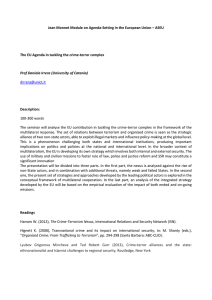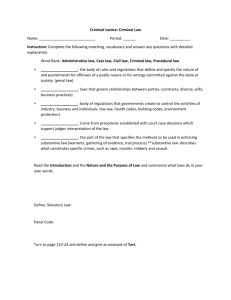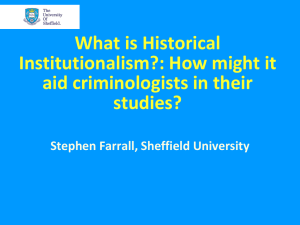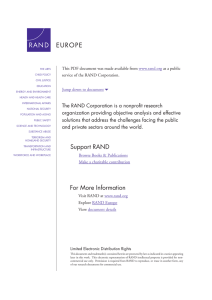University of Surrey talk 2014
advertisement
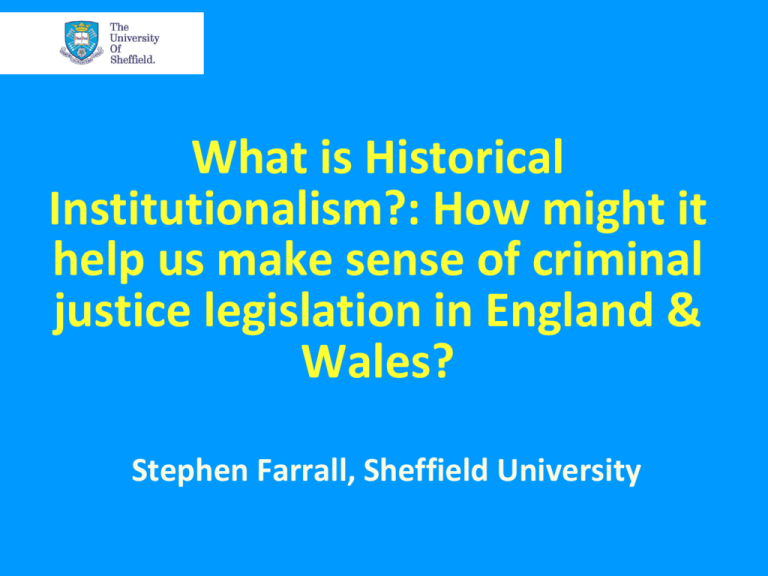
What is Historical Institutionalism?: How might it help us make sense of criminal justice legislation in England & Wales? Stephen Farrall, Sheffield University Outline • Introduce historical institutionalism; give a flavour of it’s key concepts and some of it’s weaknesses. • Briefly outline our current ESRC grant (on the legacy of Thatcherite social and economic policies for crime) Award no. ES/K006398/1. • Explore these issues via an examination of key elements of 1982-1998 criminal justice legislation. • Conclude that key institutions, ideas and social actors all helped to shape the pathway with regards to imprisonment in England and Wales. • Reflect on what this tells us about this approach. What is HI? • Institutions are: “… the formal rules, compliance procedures, and standard operating practices that structure the relationship between individuals in various units of the policy and economy” (Hall, 1986: 19). [social norms, states, govts] • HI is concerned with illuminating how institutions and institutional settings mediate the ways in which processes unfold over time (Thelen and Steinmo, 1992: 2) • “… neither a particular theory nor a specific method. It is best understood as an approach to studying politics. This approach is distinguished from other social science approaches by its attention to real world empirical questions, its historical orientation and its attention to the ways in which institutions structure and shape political behaviour and outcomes.”. Steinmo, 2008. What is HI? • Institutionalists are interested in how institutions are constructed, maintained and adapted over time. • Institutions do not simply channel policies; they help to define policy concerns, create the objects of any policy and shape the nature of the interests in policies which actors may have. • Politics does not simply create policies; policies also create politics. • Longitudinal in focus. HI is an attempt to develop understanding of how political and policy processes and relationships play out over time coupled with an appreciation that prior events, procedures and processes will have consequences for subsequent events. What are the main concepts within HI? • Path Dependencies: what happened at an earlier point will affect what can happen later. Reversal costs are high and institutional arrangements hard to completely ‘undo’. Policy concerns and interests become constructed within parameters. • Positive feedback loops: once a set of institutions is in place, actors, organisations and other institutions adapt their activities in ways which reflect and reinforce the path. • Timings and event sequences: both the timing and ordering of events can shape outcomes. • The speed of causal processes and outcomes: there are both fast- and slow-moving causal processes and outcomes (cumulative, threshold and chain causal processes). Last two radically alter the time-frames of our explanations. What are the main concepts within HI? • Critical junctures: those rare and relatively short-lived periods when institutional arrangements are placed on a particular path. During these periods actors may be able to produce significant change. • Punctuated equilibrium: long-run stability in policy-making is subject to occasional seismic shifts when existing institutions and issue definitions break down and pressure for change accumulates to the point where is cannot be ignored. • I think this last point resonates with Mark Olssen’s comments on bifurcation and changes in equilibrium yesterday. … and what are the problems with it? • ideas also matter too (not just institutions), so does HI underplay the importance of actors, perhaps?: • too much focus on reproduction of institutions? (similar to critiques of theories of structuration); • focus on political elites (little about the populous); • important to remember that not all institutions will be changed, adapted or maintained and that the speeds of change may be variable too. • Ignores new events and processes which may dramatically alter paths – Mark Olssen’s talk yesterday. Using these ideas in our research: Criminal Justice Acts 1982-1998 What might a ‘Thatcherised’ CJS have looked like? Social workers ‘‘created a fog of excuses in which the muggers and burglars operate’’, Riddell, 1989:171). [anti-penal welfarism?] “Safety on the streets” (Riddell, 1985: 193). “never … economise on law and order” (Savage, 1990: 91). [crime control models of policing?] Pro-capital punishment. [harsher penalties?] But what did we actually get? (Or: The Absence of ‘Thatcherite’ Action on Criminal Justice) • 1982-1991: Generally speaking, liberal policies, but with the rhetoric of ‘toughening’ sentences (in order to reduce the use of imprisonment). • 1993 and since: few (if any) liberal criminal justice policies, a lot more punitive sentences. BUT, and crucially these build on the rhetoric of toughness established earlier. So ‘getting tough’ after Thatcher’s time in office. Shifting Social Attitudes (BSAS) Changes to the legislative agenda: Proportion of attention to law and crime in Queen’s Speech (from policyagendas.org) Making Sense of this ... • The desire to reduce imprisonment was a longstanding Home Office aspiration. • But following the death of the rehabilitative ideal and the emergence of New Right rhetoric, the route to reducing imprisonment was to toughen non-custodial sentences. • This toughening was initially targeted on a few types of offences/offenders. Making Sense of this ... • Back in the ‘real world’, crime rates and anxiety about crime were rising (a new element of discourse following the expansion of surveys - BCS in 1982, BSAS in 1983). • Popular attitudes towards crime were shifting too, and this encouraged changes in agendas. • Michael Howard’s arrival at the Home Office was a critical appointment; recognised anxiety rejected HO doctrine and adopted toughness as a policy stance. Making Sense of this ... • Institutional aims + punctuated equilibrium (Home Office). • The role of ideas (rehabilitation, popular concerns) and of new knowledge. • The role of specific agents who ‘shape paths’ (Michael Howard). • Outcomes at national level (see next slide). Outcomes for real people Prison Popn 1970-2013 1970 1980 1990 year 2000 1970: 39028 Average Prison Popn (Key years): 1979: 42220 1993: 44552 1994: 48621 2010 2013: 84249 What have we learnt? • HI does feel slightly too ‘sticky’; social actors do have roles to play/power; but possibly only certain ones and at certain moments. Agency is real (for some). • That said, Labour have followed (and extended) Howard’s lead, so path dependencies can be said to exist. • Ideas and new forms of knowledge are key during moments of change; at points of change it might be possible for some social actors to create quite radical changes if their ideas strike the right chords. • The 1970s was one such moment for UK society, the 1990s another for our criminal justice system. Slow-mo’ processes. Outline of future work ESRC grant with Colin Hay, Emily Gray and Will Jennings. • Data sets to be made available • Training workshop (with UK Data Service May 2015) • Documentary Film (Doc Fest 2015) • http://www.sheffield.ac.uk/law/research/projects/crimetrajectories • Email newsletter (s.farrall@sheffield.ac.uk) • Twittering: @Thatcher’s Legacy
